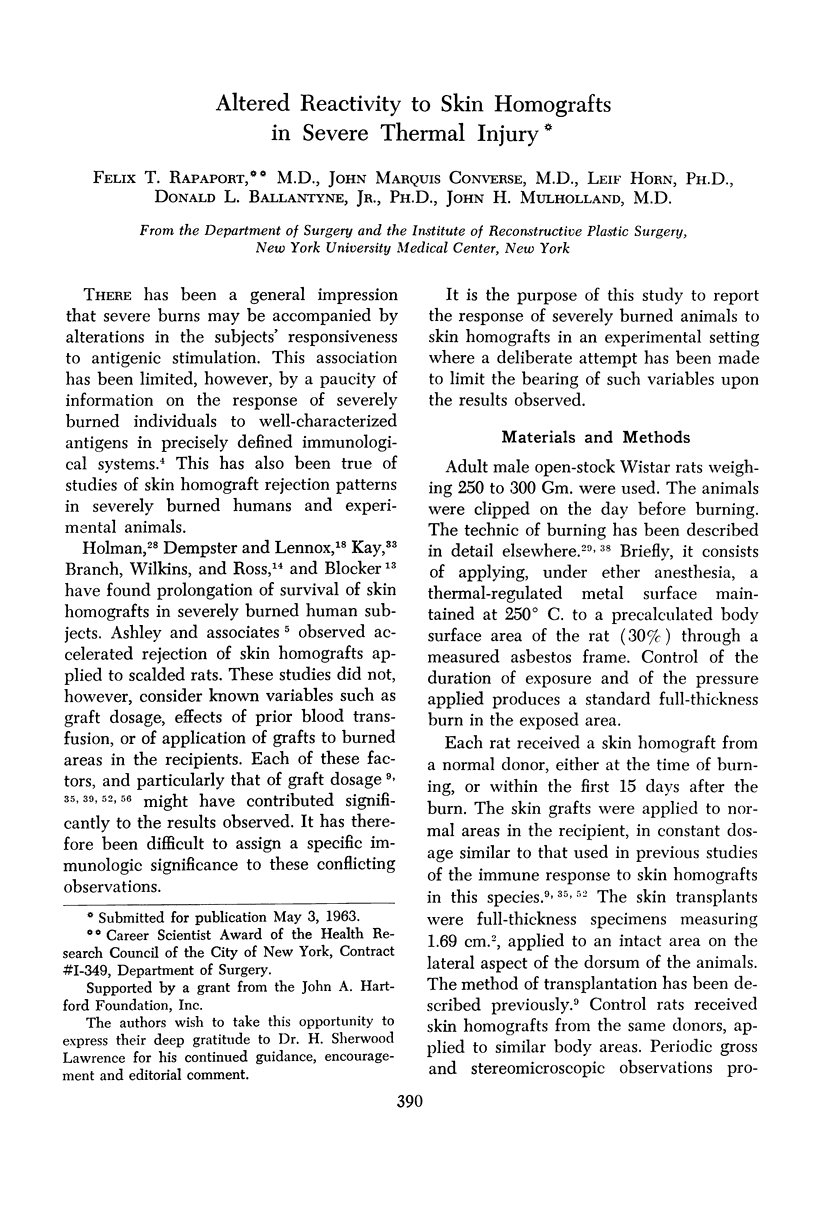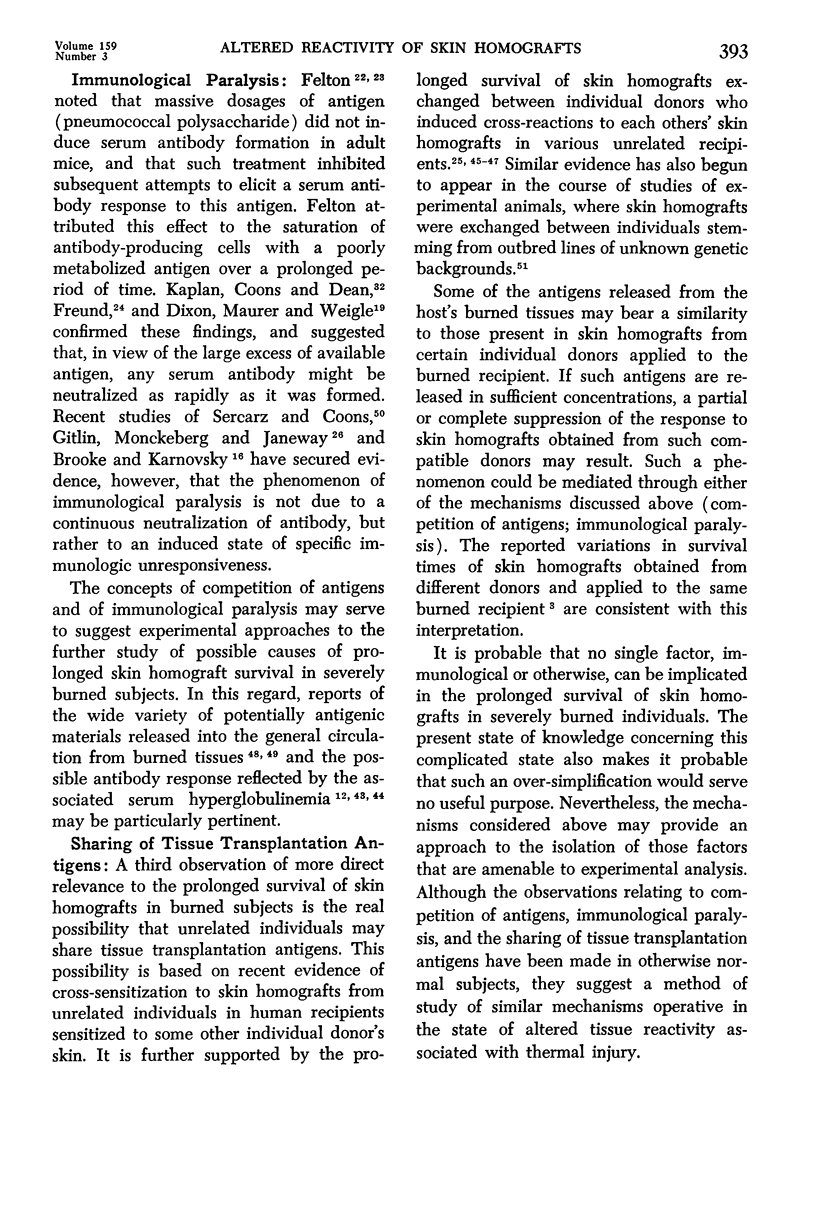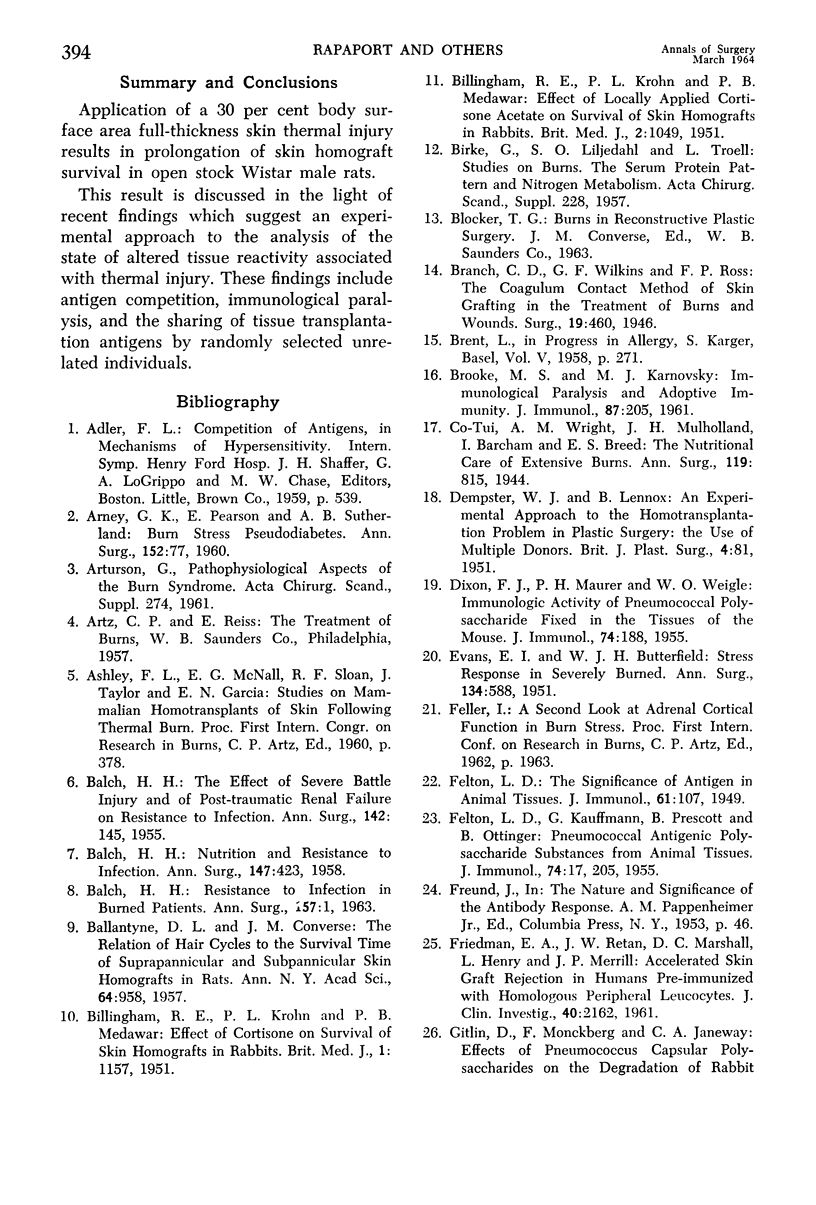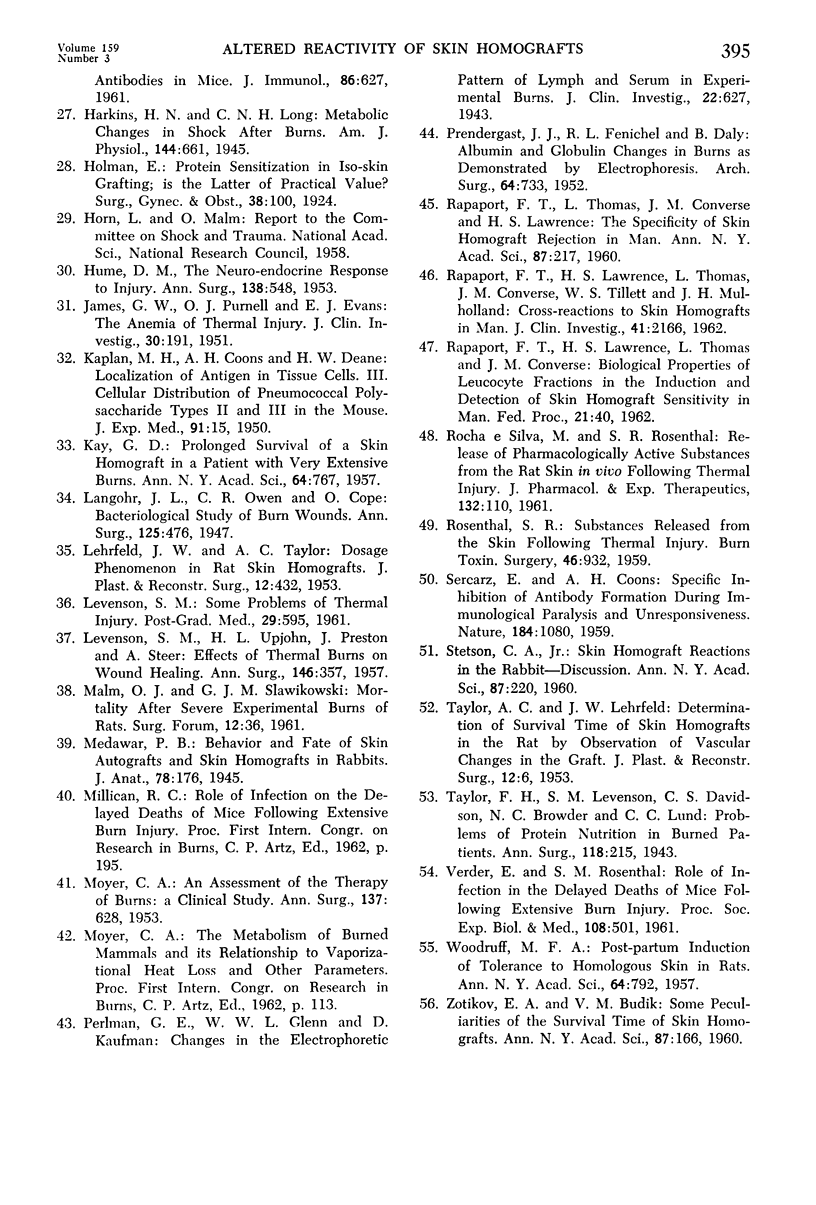Full text
PDF





Selected References
These references are in PubMed. This may not be the complete list of references from this article.
- ARNEY G. K., PEARSON E., SUTHERLAND A. B. Burn stress pseudodiabetes. Ann Surg. 1960 Jul;152:77–90. doi: 10.1097/00000658-196007000-00012. [DOI] [PMC free article] [PubMed] [Google Scholar]
- BALCH H. H. Nutrition and resistance to infection. Ann Surg. 1958 Mar;147(3):423–424. doi: 10.1097/00000658-195803000-00021. [DOI] [PMC free article] [PubMed] [Google Scholar]
- BALCH H. H. Resistance to infection in burned patients. Ann Surg. 1963 Jan;157:1–19. doi: 10.1097/00000658-196301000-00001. [DOI] [PMC free article] [PubMed] [Google Scholar]
- BALCH H. H. The effect of severe battle injury and of post-traumatic renal failure on resistance to infection. Ann Surg. 1955 Aug;142(2):145–163. doi: 10.1097/00000658-195508000-00001. [DOI] [PMC free article] [PubMed] [Google Scholar]
- BALLANTYNE D. L., Jr, CONVERSE J. M. The relation of hair cycles to the survival time of suprapannicular and subpannicular skin homografts in rats. Ann N Y Acad Sci. 1957 Mar 22;64(5):958-63; discussion, 963-6. doi: 10.1111/j.1749-6632.1957.tb52487.x. [DOI] [PubMed] [Google Scholar]
- BILLINGHAM R. E., KROHN P. L., MEDAWAR P. B. Effect of cortisone on survival of skin homografts in rabbits. Br Med J. 1951 May 26;1(4716):1157–1163. doi: 10.1136/bmj.1.4716.1157. [DOI] [PMC free article] [PubMed] [Google Scholar]
- BILLINGHAM R. E., KROHN P. L., MEDAWAR P. B. Effect of locally applied cortisone acetate on survival of skin homografts in rabbits. Br Med J. 1951 Nov 3;2(4739):1049–1053. doi: 10.1136/bmj.2.4739.1049. [DOI] [PMC free article] [PubMed] [Google Scholar]
- BRENT L. Tissue transplantation immunity. Prog Allergy. 1958;5:271–348. [PubMed] [Google Scholar]
- DEMPSTER W. J., LENNOX B. An experimental approach to the homotransplant problem in plastic surgery: the use of multiple donors. Br J Plast Surg. 1951 Jul;4(2):81–87. doi: 10.1016/s0007-1226(51)80013-4. [DOI] [PubMed] [Google Scholar]
- DIXON F. J., MAURER P. H., WEIGLE W. O. Immunologic activity of pneumococcal polysaccharide fixed in the tissues of the mouse. J Immunol. 1955 Mar;74(3):188–191. [PubMed] [Google Scholar]
- EVANS E. I., BUTTERFIELD W. J. H. The stress response in the severely burned: an interim report. Ann Surg. 1951 Oct;134(4):588–613. doi: 10.1097/00000658-195110000-00007. [DOI] [PMC free article] [PubMed] [Google Scholar]
- FELTON L. D., PRESCOTT B., KAUFFMANN G., OTTINGER B. Pneumococcal antigenic polysaccharide substances from animal tissues. J Immunol. 1955 Mar;74(3):205–213. [PubMed] [Google Scholar]
- FRIEDMAN E. A., RETAN J. W., MARSHALL D. C., HENRY L., MERRILL J. P. Accelerated skin graft rejection in humans preimmunized with homologous peripheral leukocytes. J Clin Invest. 1961 Dec;40:2162–2170. doi: 10.1172/JCI104442. [DOI] [PMC free article] [PubMed] [Google Scholar]
- GITLIN D., MONCKEBERG F., JANEWAY C. A. Effects of pneumococcus capsular polysaccarides on the degradation of rabbit antibodies in mice. J Immunol. 1961 Jun;86:627–634. [PubMed] [Google Scholar]
- HUME D. M. The neuro-endocrine response to injury: present status of the problem. Ann Surg. 1953 Oct;138(4):548–557. doi: 10.1097/00000658-195310000-00007. [DOI] [PMC free article] [PubMed] [Google Scholar]
- JAMES G. W., 3rd, PURNELL O. J., EVANS E. I. The anemia of thermal injury. II. Studies of liver function. J Clin Invest. 1951 Feb;30(2):191–199. doi: 10.1172/JCI102431. [DOI] [PMC free article] [PubMed] [Google Scholar]
- KAY G. D. Prolonged survival of a skin homograft in a patient with very extensive burns. Ann N Y Acad Sci. 1957 Mar 22;64(5):767–774. doi: 10.1111/j.1749-6632.1957.tb52471.x. [DOI] [PubMed] [Google Scholar]
- LEHRFELD J. W., TAYLOR A. C. The dosage phenomenon in rat skin homografts. Plast Reconstr Surg (1946) 1953 Dec;12(6):432–438. doi: 10.1097/00006534-195312000-00006. [DOI] [PubMed] [Google Scholar]
- LEVENSON S. M., UPJOHN H. L., PRESTON J. A., STEER A. Effect of thermal burns on wound healing. Ann Surg. 1957 Sep;146(3):357–368. [PMC free article] [PubMed] [Google Scholar]
- MALM O. J., SLAWIKOWSKI J. M. Mortality, after severe experimental burns, of rats treated with chloromycetin and with sera of rats convalescing from burns or from open wounds. Surg Forum. 1961;12:36–38. [PubMed] [Google Scholar]
- MOYER C. A. An assessment of the therapy of burns; a clinical study. Ann Surg. 1953 May;137(5):628–638. doi: 10.1097/00000658-195305000-00006. [DOI] [PMC free article] [PubMed] [Google Scholar]
- Medawar P. B. The behaviour and fate of skin autografts and skin homografts in rabbits: A report to the War Wounds Committee of the Medical Research Council. J Anat. 1944 Oct;78(Pt 5):176–199. [PMC free article] [PubMed] [Google Scholar]
- PRENDERGAST J. J., FENICHEL R. L., DALY B. M. Albumin and globulin changes in burns as demonstrated by electrophoresis. AMA Arch Surg. 1952 Jun;64(6):733–740. doi: 10.1001/archsurg.1952.01260010753001. [DOI] [PubMed] [Google Scholar]
- Perlmann G. E., Glenn W. W., Kaufman D. CHANGES IN THE ELECTROPHORETIC PATTERN IN LYMPH AND SERUM IN EXPERIMENTAL BURNS. J Clin Invest. 1943 Jul;22(4):627–633. doi: 10.1172/JCI101434. [DOI] [PMC free article] [PubMed] [Google Scholar]
- RAPAPORT F. T., LAWRENCE H. S., THOMAS L., CONVERSE J. M., TILLETT W. S., MULHOLLAND J. H. Cross-reactions to skin homografts in man. J Clin Invest. 1962 Dec;41:2166–2172. doi: 10.1172/JCI104675. [DOI] [PMC free article] [PubMed] [Google Scholar]
- RAPAPORT F. T., THOMAS L., CONVERSE J. M., LAWRENCE H. S. The specificity of skin homograft rejection in man. Ann N Y Acad Sci. 1960 May 31;87:217–222. doi: 10.1111/j.1749-6632.1960.tb23195.x. [DOI] [PubMed] [Google Scholar]
- ROCHA E SILVA M., ROSENTHAL S. R. Release of pharmacologically active substances from the rat skin in vivo following thermal injury. J Pharmacol Exp Ther. 1961 Apr;132:110–116. [PubMed] [Google Scholar]
- ROSENTHAL S. R. Substances released from the skin following thermal injury: "burn toxin". Surgery. 1959 Nov;46:932–947. [PubMed] [Google Scholar]
- SERCARZ E., COONS A. H. Specific inhibition of antibody formation during immunological paralysis and unresponsiveness. Nature. 1959 Oct 3;184(Suppl 14):1080–1082. doi: 10.1038/1841080a0. [DOI] [PubMed] [Google Scholar]
- Taylor F. H., Levenson S. M., Davidson C. S., Browder N. C., Lund C. C. PROBLEMS OF PROTEIN NUTRITION IN BURNED PATIENTS. Ann Surg. 1943 Aug;118(2):215–220. doi: 10.1097/00000658-194308000-00005. [DOI] [PMC free article] [PubMed] [Google Scholar]
- Tui C., Wright A. M., Mulholland J. H., Barcham I., Breed E. S. The Nutritional Care of Cases of Extensive Burns : With Special Reference to the Oral Use of Amino-Acids (Amigen) in Three Cases. Ann Surg. 1944 Jun;119(6):815–823. doi: 10.1097/00000658-194406000-00002. [DOI] [PMC free article] [PubMed] [Google Scholar]
- VERDER E., ROSENTHAL S. M. Role of infection in the delayed deaths of mice following extensive burn injury. Proc Soc Exp Biol Med. 1961 Nov;108:501–505. doi: 10.3181/00379727-108-26978. [DOI] [PubMed] [Google Scholar]
- WOODRUFF M. F. Postpartum induction of tolerance to homologous skin in rats. Ann N Y Acad Sci. 1957 Mar 22;64(5):792-7; discussion, 797-8. doi: 10.1111/j.1749-6632.1957.tb52473.x. [DOI] [PubMed] [Google Scholar]


